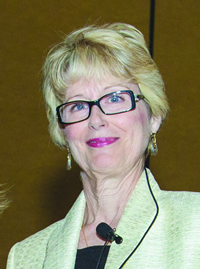If there is one consistent theme running through the 50-year history of the AHRP, it’s that its members have pushed the envelope until their new ideas became routine.

So said Teresa J. Brady, PhD, Senior Behavioral Scientist in the Arthritis Program at the Centers for Disease Control and Prevention. She spoke Monday morning as the ARHP Distinguished Lecturer: Reclaim Life! Celebrating 50 Years of Advances in Rheumatology Health Professional Practice.
“We started out as radical rebels,” Dr. Brady said, “and it became standard of practice.”
That spirit of challenging the status quo in hopes of improving their patients’ lives ran through what Dr. Brady categorized into three broad areas of advancement during the past five decades: science-driven paradigm shifts in practice, evolutions in practice, and cross-cutting challenges.
In addition to experiencing the evolution through her professional life, Dr. Brady has also been witness to the welcome changes in her personal life: She was diagnosed with rheumatoid arthritis in the early 1970s at the age of 21.
Views on exercise for arthritis patients represent one of the science-driven paradigm shifts, Dr. Brady said.
The prevailing view around the time of ARHP’s establishment was that arthritis patients needed rest. Proper exertion was about five to 10 minutes of bed exercises once or twice a day, increasing to 30 minutes.
Fast-forward to today, she said, and exercise is known to be beneficial for arthritis patients, and the expectation is that people with arthritis should aspire to the same amount of weekly exercise as the general public.
“That is a far cry from putting people to bed once they got arthritis,” Dr. Brady said.
She said that challenges remain in getting more people with arthritis to exercise. They still exercise less than people without arthritis, according to at least one study.
Dr. Brady noted the increased acknowledgement of nurses within rheumatology and greater specialization among nurses as one of practice evolutions over the past 50 years.
Back in the 1960s, nurses were not even mentioned in descriptions of arthritis clinics. It was an era in which nursing was only “vaguely described,” she said. A key milestone in the evolution of nursing in rheumatology was being recognized as a nursing specialty in 2012 by the American Nurses Association.
More specialization has come in the form of nurse practitioners and physician assistants.
The challenge ahead comes in not losing that focus on the clinic as nurses pursue higher academic degrees and credentialing. The bottom line is that “nurses focus on educating the patient,” she said.
Dr. Brady identified a number of cross-cutting challenges ahead, including ensuring access to care in an era of growing patient demand, physician shortages, and high-cost medications. Rheumatology professionals also will need to effectively adapt to new technology, such as electronic medical records and the personal monitors and health trackers.
Overall, the environment for rheumatology professionals has improved.
“It is a far better world today than it was in the past,” she said.
